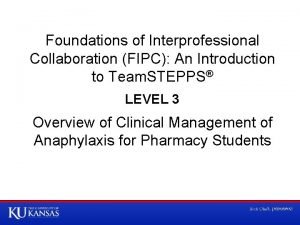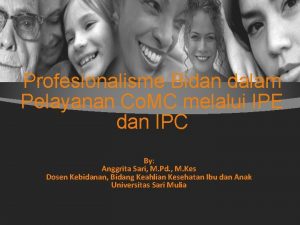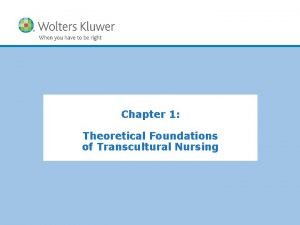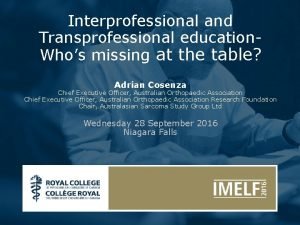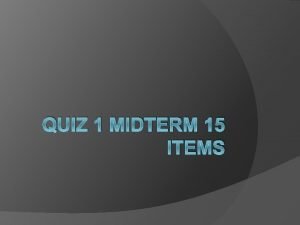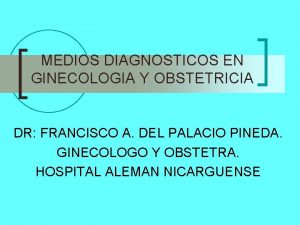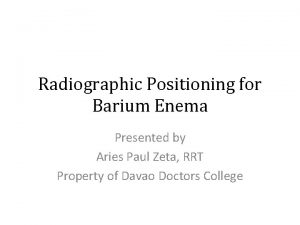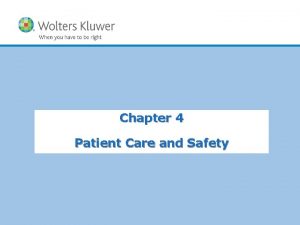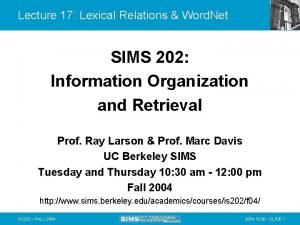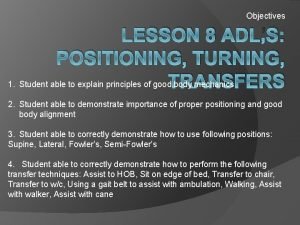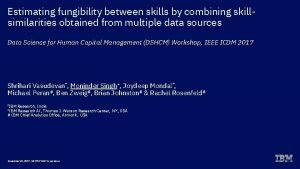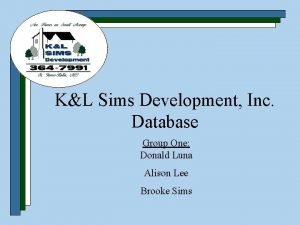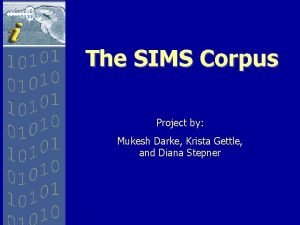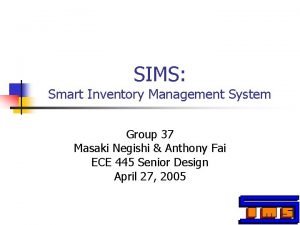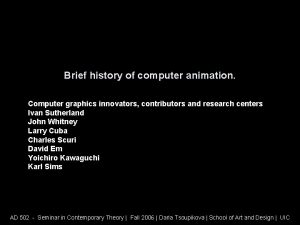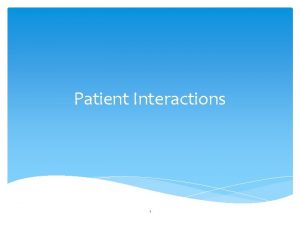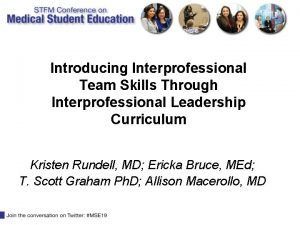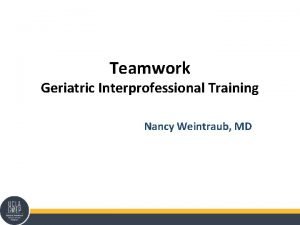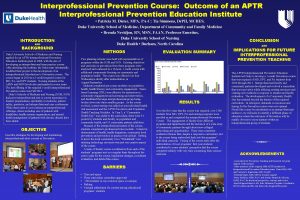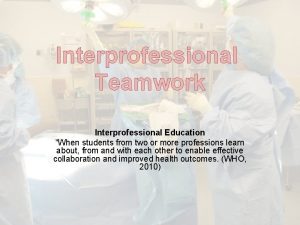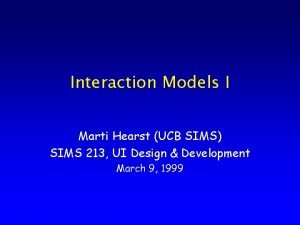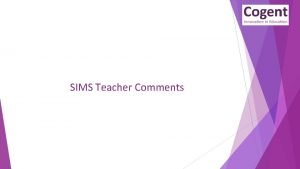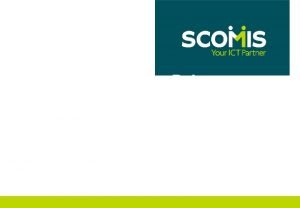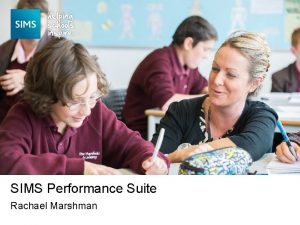Interprofessional Patient Interactions EMILY DEDONATO ERIKA SIMS DANIEL






















- Slides: 22

Interprofessional Patient Interactions EMILY DEDONATO ERIKA SIMS DANIEL YANES

AGENDA �We interviewed several healthcare providers and professional students on how they interview patients �Today we will compare and contrast the interviewing techniques and training of the following fields: Medicine Pharmacy Nursing Physical Therapy Dentistry Social Work

WHY IS THIS IMPORTANT? �Each field has its own methods and tactics when it comes to talking to a patient �Understanding how each provider interviews a patient helps get a glimpse into the care that they provide Which things do different providers emphasize? What information is best gathered by a specific provider? Can we learn and utilize skills from different disciplines and incorporate them into our own patient interactions?

MEDICINE �COMPONENTS OF THE INTERACTION HPI - CODIERS PMH SHx and FHx ROS Physical Exam �Points of emphasis Open-ended questions and patient-centered interviewing Eliciting the patient’s story in full detail to help guide medical decision making � Must be comprehensive and thorough Key physical exam findings, both normal and abnormal

PHARMACY WHAT ARE YOUR THOUGHTS?

PHARMACY �HPI SCHOLAR-MAC � Symptoms, characteristics, history, onset, location, aggravating factors, remitting factors, medications, allergies, concomitant conditions HPI is largely focused on current problem and other problems that could interfere with medications/induce side effects �Training All questions must be open ended � “Do you have any questions? ” vs. “What questions do you have? ” � Start broad and go narrow “What meds do you use” “Are you taking any OTC medications? ”

PHARMACY �How it differs from medicine Interview is centered around medications and side effects � Adherence to medication regimen � Diet, nutrition, etc. Cost of medication and assessment of formulary is a key component of interviewing � The most efficacious drug may not be the most available Less emphasis on physical exam �Overall, very similar interview to physicians with a slightly shifted focus SOAP Notes, thorough HPI, etc.

NURSING What are your thoughts?

NURSING �COMPONENTS OF THE INTERACTION SBAR – Situation, Background, Assessment, Recommendation �S – Here’s the situation � B – Relevant PMH, Vitals, acute events, etc. � A – “I think her blood pressure is too high” � R – “Can we go up on the beta blocker? ” �Incredibly variable – spoke to 15 different nurses/nursing students, training and interviewing differs depending on area of specialization �Points of emphasis Obtaining the most relevant information Focusing on patterns in patient care (how much they slept, I/Os, periodic assessment and re-assessment)

NURSING �How it differs from medicine Focused interview and physical exam to look for subtle changes (vs. broader interview to formulate treatment plan) More emphasis on review of systems and constant monitoring See the patients in the hospital more frequently than physicians do �Overall, very variable Wide range of responsibilities and tasks depending on area of focus (i. e. Cardiac ICU vs. outpatient family medicine) Nursing assessment informs physician’s plan, and physician’s assessment informs nursing’s plan

PHYSICAL THERAPY What are your thoughts?

PHYSICAL THERAPY �COMPONENTS OF THE INTERACTION Background information Review of systems Patient interview – establishing diagnosis, monitor progress, and treatment strategy � CC, How were you injured? When? Etc. � What are the GOALS of treatment �Points of emphasis Treatment priorities – Treat pain? Achieve mobility? Avoid weakness? Etc. Conducting physical therapy – actively showing exercises and assessing mobility

PHYSICAL THERAPY �How it differs from medicine Physical exam is largely musculoskeletal – full assessment of ROM, capacity, etc. � Incredible detail Emphasize social history and goals of treatment � “Cure” is not always a reasonable option, so quality of life is a major component of PT � Age is often a key factor Active engagement in performing PT and physically assessing the patient is often part of the interview (vs. medicine where procedures are separate) �Overall, PT focuses heavily on quality of life and is often consulted after a diagnosis or concern has been identified

DENTISTRY What are your thoughts?

DENTISTRY �COMPONENTS OF THE INTERACTION Largely focused on dental examination as opposed to interviewing per se � Much of the initial assessment is often performed by dental hygienists Highly procedural and concerned about both dental health and cosmetic outcomes �Points of emphasis Making the patient feel comfortable � Many people fear the dentist or do not recognize the importance of dental hygiene, and thus favorable interactions are key Focus on changes rather than HPI/CC based interviewing � Less open-ended and more procedural

DENTISTRY �How it differs from medicine Interviewing to elicit information is less of an emphasis in dentistry More focused exam – head, neck, mouth, ENT �Overall, very directed patient interactions, often focused on changes and deviations from norm, rather than an inciting event or acute complaint Very procedural Amicability is especially important for patients who may be uncomfortable

SOCIAL WORK What are your thoughts?

SOCIAL WORK �COMPONENTS OF INTERACTION: PIE (Person in Environment) focused assessment � Political, familial, institutional, physical, spiritual, social, cultural Psychosocial assessment � Goal/desired outcome, Family information, Risk assessment/safety screen (general safety, violence, drug/alcohol use, etc. ), support system, clinical recommendation �Points of emphasis Openness and transparency with patients � If a report to CPS must be made, the patients are told � Goal is to empower patients Barriers to care, discharge, or follow up Economic resources and needs

SOCIAL WORK �How it differs from medicine? Focuses on the patient’s environment and access to care, rather than treating a particular ailment No physical examination or review of systems needed �Overall, focus on psychosocial and holistic well-being and ensures proper access and resources to care The interview of a social worker can provide information that physicians may not be able to get at in their interview

WHAT VALUABLE SKILLS CAN WE INCORPORATE INTO OUR OWN INTERVIEW? �PHARMACY When considering medications, think more about cost and access to medicine �NURSING Focus on details and subtle changes in our patients, obtaining both a broad and narrow assessment �PHYSICAL THERAPY Consider goals and priorities when thinking about patient care and treatment plans �DENTISTRY Ensure patient satisfaction and attempt to make experiences positive �SOCIAL WORK Think about the patient in their environment, and treat not just the patient, but their situation as well

THANK YOU �Thank you to all other healthcare professionals that were contacted and provided information for this project �A special thank you to the following people for allowing us to conduct in-depth interviews Pharmacy: Steven Kiss, UNC Pharmacy Nursing: Laura Niese, RN, Shelby Kiskis, RN, Brodie Babbo, RN Dentistry: Judy Reu, D 3, The Ohio State University Physical Therapy: Dr. Brenna Congeni, DPT Social Work: Nicole Parente, MSW

QUESTIONS?
 Erika sims
Erika sims Interprofessional care for anaphylaxis
Interprofessional care for anaphylaxis Ipe dalam kebidanan
Ipe dalam kebidanan Theoretical foundation of nursing chapter 1
Theoretical foundation of nursing chapter 1 Transprofessional vs interprofessional
Transprofessional vs interprofessional Patient 2 patient
Patient 2 patient Anatomy of a rectum
Anatomy of a rectum Craig sims parkway, augusta, ga
Craig sims parkway, augusta, ga Capita sims alumni
Capita sims alumni Jake simpson sims 2
Jake simpson sims 2 Test de sims huhner
Test de sims huhner Left sim's position for enema
Left sim's position for enema Sims position
Sims position Sims.net demo
Sims.net demo Alcohol poisoning vs hangover
Alcohol poisoning vs hangover Semi fowlers position
Semi fowlers position The sims 4 sexpertise skill
The sims 4 sexpertise skill Sims
Sims Diana stepner
Diana stepner Histoire de la pologne
Histoire de la pologne Conclusion of positioning in nursing
Conclusion of positioning in nursing Sims 4 inventory management
Sims 4 inventory management Brief history of computer graphics
Brief history of computer graphics

